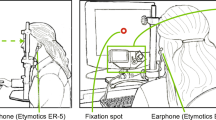Abstract
Baboons were trained in both auditory and visual reaction time procedures to release a response lever in the presence of low-intensity stimuli. By varying the stimulus intensity from trial to trial, functions relating reaction time (elapsed time from stimulus onset to lever release) to stimulus intensity were established, and detection thresholds were measured. The effects of acute, IM injections of d-methamphetamine (0.001–1.0 mg/kg) were examined on these psychophysical performance baselines. Reaction times for acoustic stimuli generally were faster for higher drug doses, whereas reaction times for visual stimuli either lengthened or shortened, depending on both drug dose and individual differences among animals. Auditory thresholds were unaffected at all drug doses studied, whereas visual thresholds were generally elevated at doses of 0.1 mg/kg and above.
Similar content being viewed by others
References
Bauer RH, Fuster JM (1978) Effects of d-amphetamine and prefrontal cortical cooling on delayed matching-to-sample behavior. Pharmacol Biochem Behav 8:243–249
Delay ER, Steiner NO, Isaac W (1979) Effects of d-amphetamine and methylphenidate upon auditory threshold in the squirrel monkey. Pharmacol Biochem Behav 10:861–864
Dews P, Morse WH (1961) Behavioral pharmacology. Annu Rev Pharmacol 1:145–174
Frowein HW (1981) Selective effects of barbiturate and amphetamine on information processing and response execution. Acta Psychol 47:105–115
Geller I, Hartmann RJ, Moran E (1983) Phenobarbital and d-amphetamine effects on discrimination performance of rats and juvenile baboons. Pharmacol Biochem Behav 18:107–113
Grilly DM (1977) Rate-dependent effects of amphetamine resulting from behavioral competition. Biobehav Rev 1:87–93
Hienz RD, Brady JV (1980) Psychophysical profiles differentiate drugs of abuse. Nat Inst Drug Abuse Res Monogr 34:226–231
Hienz RD, Eckerman DA (1974) Latency and frequency of responding under discrete-trial fixed-interval schedules of reinforcement. J Exp Anal Behav 21:341–355
Hienz RD, Lukas SE, Brady JV (1981) The effects of pentobarbital upon auditory and visual thresholds in the baboon. Pharmacol Biochem Behav 15:799–805
Maickel RP, Levine RM, Zabik JE (1974) Differential effects of d- and l-amphetamine on spontaneous motor activity in mice. Res Commun Chem Pathol Pharmacol 8:711–714
Martin WR, Sloan JW, Sapira JD, Jasinski DR (1971) Physiologic, subjective, and behavioral effects of amphetamine, methamphetamine, ephedrine, phenmetrazine, and methylphenidate in man. Clin Pharmacol Ther 12:245–258
Moody DB (1970) Reaction time as an index of sensory function. In: Stebbins WC (ed) Animal psychophysics: The design and conduct of sensory experiments. Appleton, New York, pp 277–302
Neill DB, Boggan WO, Grossman SP (1974a) Behavioral effects of amphetamine in rats with lesions in the corpus striatum. J Comp Physiol Psychol 86:1019–1030
Neill DB, Ross JF, Grossman SP (1974b) Effects of lesions in the dorsal or ventral striatum on locomotor activity and on locomotor effects of amphetamine. Pharmacol Biochem Behav 2:697–702
Pfingst BE, Hienz RD, Kimm J, Miller JM (1975a) Reaction-time procedure for measurement of hearing. I. Suprathreshold functions. J Acoust Soc Am 57:421–430
Pfingst BE, Hienz RD, Miller JM (1975b) Reaction-time procedure for measurement of hearing. II. Threshold functions. J Acoust Soc Am 57:431–436
Quirce CM, Vargas G, Odio M, Maickel RP (1982) Effects of d,l-amphetamine on exploratory activity in mice. Evidence for individual differences in drug response. Res Commun Subst Abuse, 3:49–56
Stebbins WC (1966) Auditory reaction time and the derivation of equal loudness contours for the monkey. J Exp Anal Behav 9:135–142
Tecce JJ, Cole JO (1974) Amphetamine effects in man: Paradoxical drowsiness and lowered electrical brain activity (CNV). Science 185:451–453
Trumbo DA, Gaillard AWK (1975) Drugs, time uncertainty, signal modality and reaction time. In: Rabbit PMA, Dornic S (eds) Attention and performance V., Academic, New York, pp 441–454
Weiss B, Laties VG (1962) Enhancement of human performance by caffeine and the amphetamines. Pharmacol Rev 14:1–36
Winer BJ (1962) Statistical principles in experimental design. McGraw-Hill, New York
Author information
Authors and Affiliations
Rights and permissions
About this article
Cite this article
Hienz, R.D., Lukas, S.E. & Brady, J.V. Effects of d-methamphetamine on auditory and visual reaction times and detection thresholds in the baboon. Psychopharmacology 85, 476–482 (1985). https://doi.org/10.1007/BF00429668
Received:
Accepted:
Issue Date:
DOI: https://doi.org/10.1007/BF00429668




